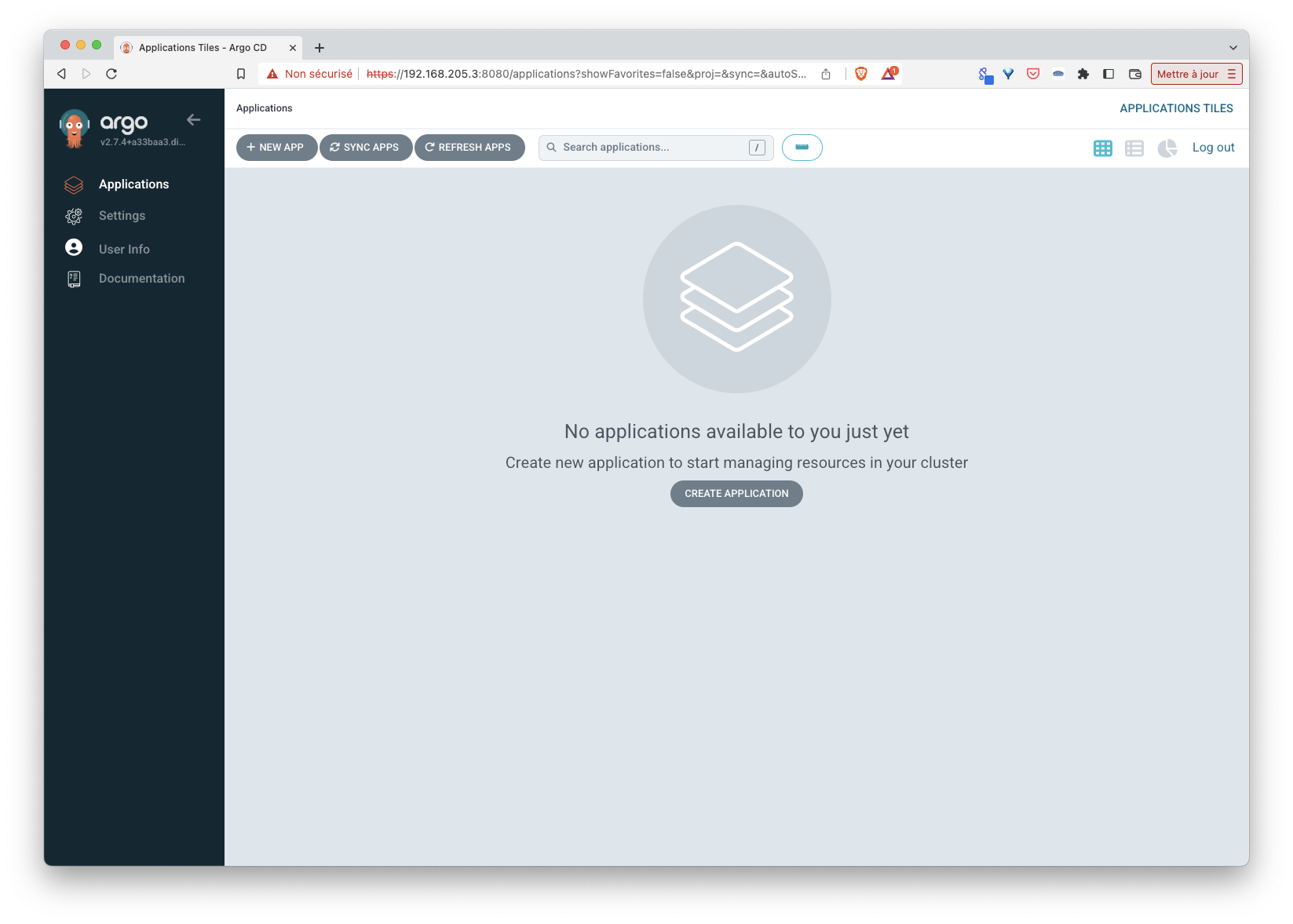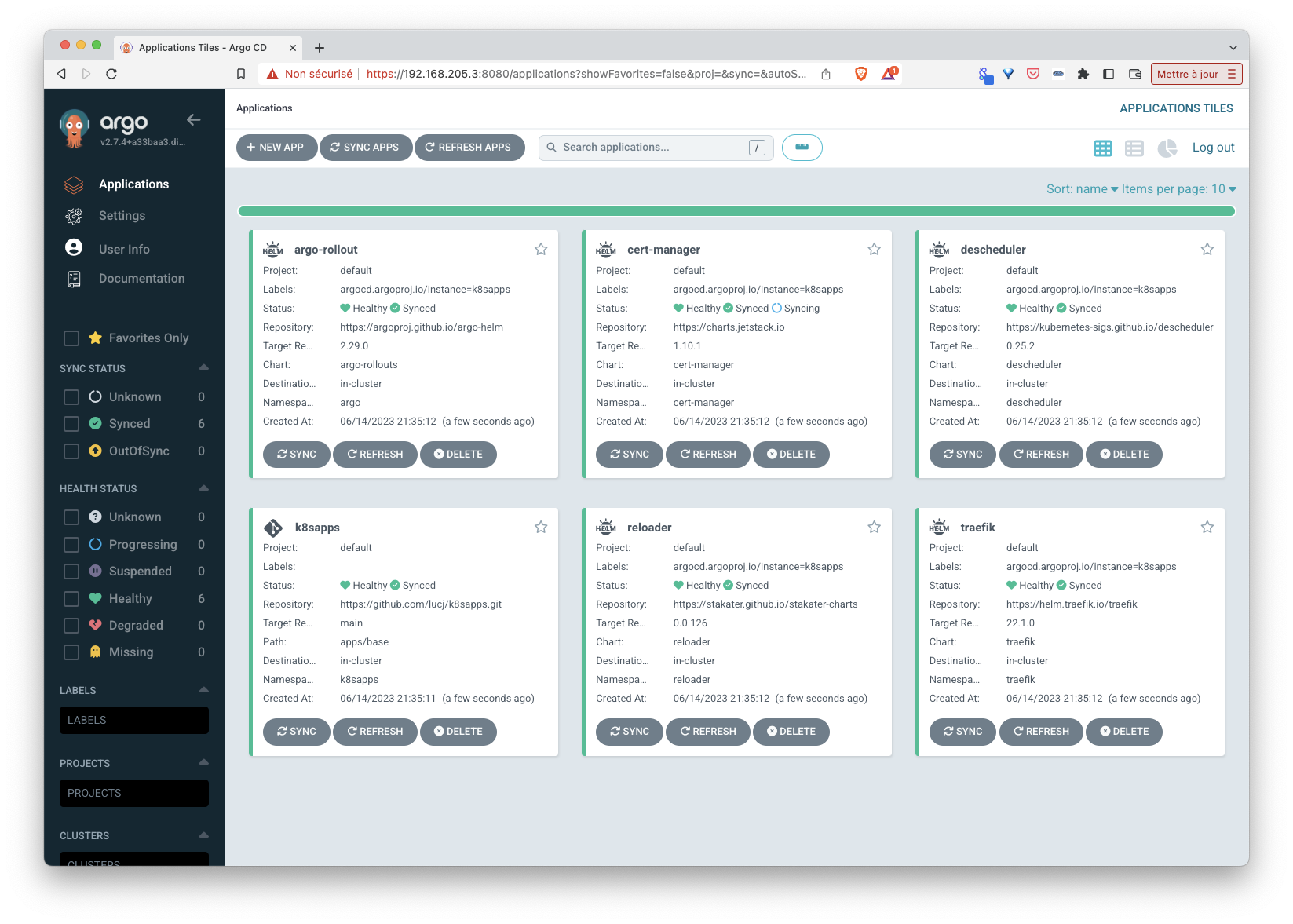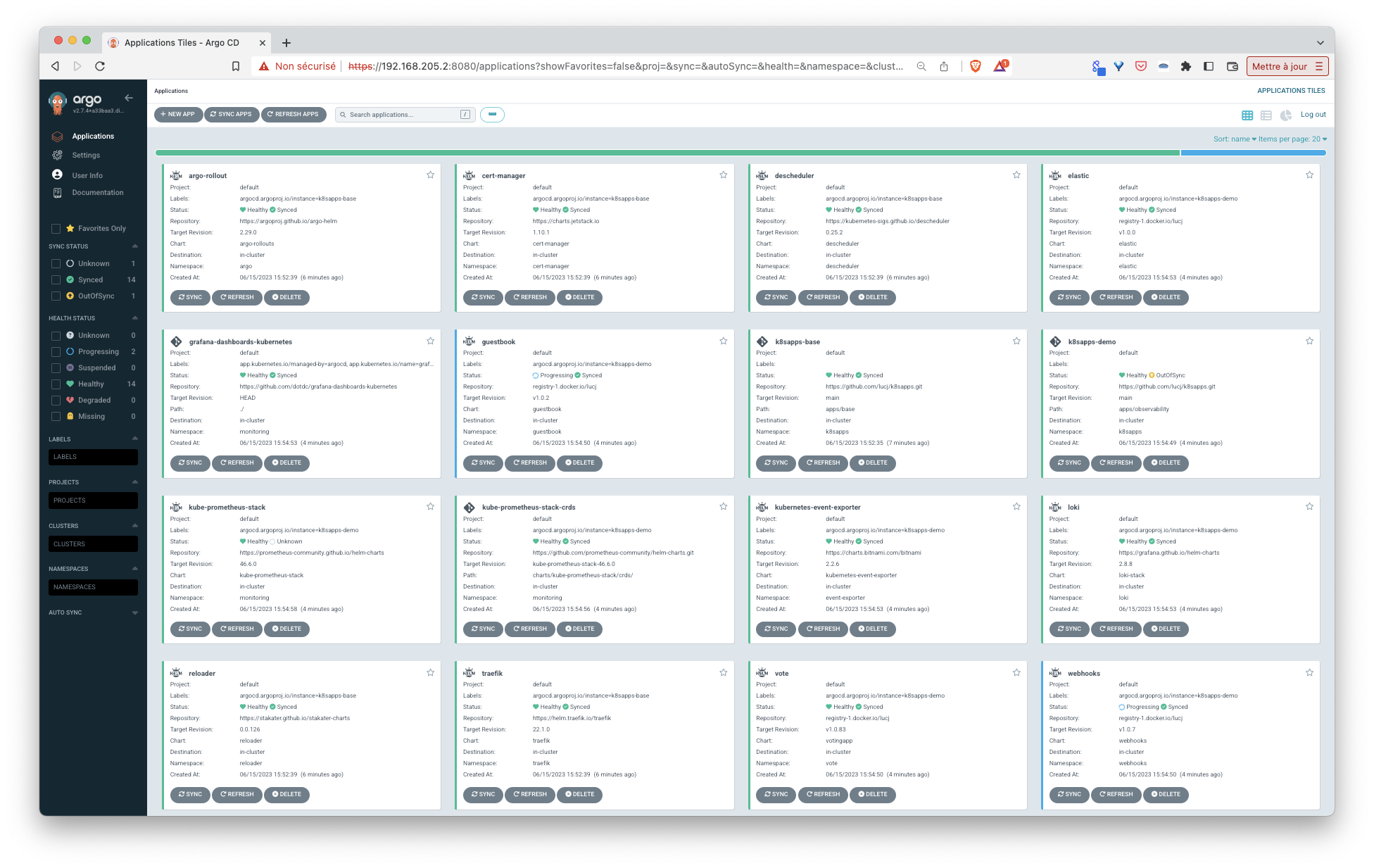This repo is mainly used for demo purposes to illustrate the App of Apps pattern where a single Argo CD's application is used to deploy all the other applications needed in the cluster.
To test things locally, we will create a one-node Kubernetes using Multipass, a great tool (available on MacOS, Windows and Linux) to spin up Ubuntu VM in a breeze.
First we create a VM named kube:
multipass launch -n kube -c 4 -d 20G -m 6G
Note: we use specific flags to give the VM more resources than the default ones (1 cpu, 1G RAM, 5G Disk) to make sure we have enough resources to install several applications. If your local machine does not have that much resources, feel free to change these settings a bit.
Next we run a shell in that VM:
multipass shell kube
Next we install k3s inside of it (making sure to remove Traefik Ingress Controller as we will use Argo CD to deploy it in the next step)
curl -sfL https://get.k3s.io | sh -s - --disable traefik
Next we configure kubectl to it uses the kubeconfig file created by k3s:
mkdir -p $HOME/.kube
sudo mv -i /etc/rancher/k3s/k3s.yaml $HOME/.kube/config
sudo chown $(id -u):$(id -g) $HOME/.kube/config
Then we make sure we have access to the cluster:
$ kubectl get node
NAME STATUS ROLES AGE VERSION
kube Ready control-plane,master 25s v1.26.5+k3s1
Install the following components on your local machine:
- Helm
- helm-diff
- Helmfile
On a Linux or MacOS machine the installation can be done with the following command:
OS=linux # change to match your current os (linux / darwin)
ARCH=arm64 # change to match your current architecture (amd64 / arm64)
# Helm
HELM_VERSION=v3.12.1
curl -sSLO https://get.helm.sh/helm-${HELM_VERSION}-$OS-$ARCH.tar.gz
tar zxvf helm-${HELM_VERSION}-$OS-$ARCH.tar.gz
sudo mv ./$OS-$ARCH/helm /usr/local/bin
# Helm-diff
HELM_DIFF_VERSION="3.8.1"
helm plugin install https://github.com/databus23/helm-diff --version ${HELM_DIFF_VERSION}
# Helmfile
HELMFILE_VERSION=0.154.0
curl -sSLO https://github.com/helmfile/helmfile/releases/download/v${HELMFILE_VERSION}/helmfile_${HELMFILE_VERSION}_${OS}_$ARCH.tar.gz
tar zxvf helmfile_${HELMFILE_VERSION}_${OS}_$ARCH.tar.gz
sudo mv ./helmfile /usr/local/bin/Note: Helmfile is a very handy tool which allows to use specify Helm charts in a declarative way
Below are 2 possibilities to install Argo CD:
- using Helm
helm repo add argo https://argoproj.github.io/argo-helm
helm install argocd argo/argo-cd --version 5.36.1 -n argocd --create-namespace
- using Helmfile
The following command installs Argo CD using Helmfile:
cat <<EOF | helmfile apply -f -
repositories:
- name: argo
url: https://argoproj.github.io/argo-helm
releases:
- name: argocd
namespace: argocd
labels:
app: argocd
chart: argo/argo-cd
version: ~5.36.1
EOF
Note: if you need to install Argo CD with a helmfile plugin and sops/age key please check INSTALLATION.md
Now Argo CD is installed, we can access its "really neat" web UI.
First we retrieve the admin password (this can take a few seconds before it is available):
kubectl -n argocd get secret argocd-initial-admin-secret -o jsonpath="{.data.password}" | base64 --decode
Next we expose the UI with a port-forward
kubectl -n argocd port-forward service/argocd-server 8080:443 --address 0.0.0.0
Then we run a browser using the IP address of the VM created above (this one can be retreived with the command multipass info kube) and port 8080. We use the admin username and the password retrieved abvove to login.
There are currently no application as we haven't created any yet.
Argo CD is up and running we can now use it to deploy applications in our cluster.
In this first example, we will use Argo CD to deploy the following apps:
- Traefik
- Argo Rollout
- Descheduler
- Cert-Manager
- Reloader
To do so, we need to tell Argo CD:
- where it can find the specification of the applications to deploy
- where we want it to deploy those apps
The file apps/base.yaml defines an Argo CD application named k8sapps-base which is an umbrella app above all the application defined in https://github.com/lucj/k8sapps/tree/main/apps/base (source key) in the current cluster (destination key). In short: creating the k8sapps-base application will automatically deploy the applications underneath.
apps/base.yaml:
apiVersion: argoproj.io/v1alpha1
kind: Application
metadata:
name: k8sapps-base
namespace: argocd
finalizers:
- resources-finalizer.argocd.argoproj.io
spec:
project: default
source:
repoURL: https://github.com/lucj/k8sapps.git
targetRevision: main
path: apps/base
destination:
server: https://kubernetes.default.svc
namespace: k8sapps
syncPolicy:
automated: {}
syncOptions:
- CreateNamespace=true
From another terminal, run the following:
kubectl apply -f https://raw.githubusercontent.com/lucj/k8sapps/main/apps/base.yaml
From the Argo CD UI we can see that the creation of the above application automatically triggers the creation of the other applications that are defined in the apps folder (traefik, cert-manager, ...).
Note: each time we will define another Application within the apps/base git folder, Argo CD will notice it and automatically deploy it
On top of base applications, additional apps are defined and grouped in different categories such as observability, security or demo under the apps folder. Creating both demo.yaml and observability.yaml applications we can see all the applications belonging to those category are deployed by Argo CD as well.
kubectl apply -f https://raw.githubusercontent.com/lucj/k8sapps/main/apps/demo.yaml
kubectl apply -f https://raw.githubusercontent.com/lucj/k8sapps/main/apps/observability.yaml
Want to add / remove an application from your cluster ? Just add / remove its specification in the corresponding Git repo and leave Argo CD do the rest ! :)
This is a work in progress. This repo is dedicated to demo purposes only.
MIT License
Copyright (c) [2023]
Permission is hereby granted, free of charge, to any person obtaining a copy of this software and associated documentation files (the "Software"), to deal in the Software without restriction, including without limitation the rights to use, copy, modify, merge, publish, distribute, sublicense, and/or sell copies of the Software, and to permit persons to whom the Software is furnished to do so, subject to the following conditions:
The above copyright notice and this permission notice shall be included in all copies or substantial portions of the Software.
THE SOFTWARE IS PROVIDED "AS IS", WITHOUT WARRANTY OF ANY KIND, EXPRESS OR IMPLIED, INCLUDING BUT NOT LIMITED TO THE WARRANTIES OF MERCHANTABILITY, FITNESS FOR A PARTICULAR PURPOSE AND NONINFRINGEMENT. IN NO EVENT SHALL THE AUTHORS OR COPYRIGHT HOLDERS BE LIABLE FOR ANY CLAIM, DAMAGES OR OTHER LIABILITY, WHETHER IN AN ACTION OF CONTRACT, TORT OR OTHERWISE, ARISING FROM, OUT OF OR IN CONNECTION WITH THE SOFTWARE OR THE USE OR OTHER DEALINGS IN THE SOFTWARE.


